| |
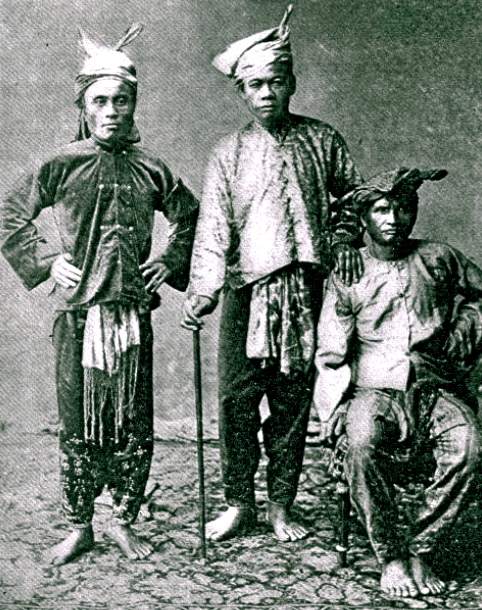 |
 |
|
Fierce and
Formidable Moro Warriors of Mindanao
In the early 1900s, U.S.
forces battled the Philippines' fiercely independent Islamic Moros.
This is a history of an obscure colonial war in which both sides fought
bravely, suffered cruelly, often behaved horribly and accomplished
little.
Called
Moros by the Spanish because they reminded
Europeans of Muslim, Moroccan Moors, the Moro tribes occupied—and still
occupy—Mindanao, the second largest Philippine island. They were
accomplished seafarers, to whom
piracy and slavery seemed natural
rights, and their small, speedy ships were remarkably elusive. Ruled by
local Datus whose arbitrary decisions were law,
Moro tribes were rivals
who often engaged in internecine warfare. The Spaniards had never been
able to pacify, much less govern, those keen warriors, not even on the
much smaller islands of the Sulu Archipelago.
At the end of the 19th century, the
Moros numbered about
265,000 while their Christian neighbors on Mindanao counted only 65,000.
Each group had a very low opinion of the other. Spaniards and Filipino
Christians saw the Moros as cruel, cunning and treacherous raiders and
slavers, whereas the Moros viewed the Christians primarily as
land-thieves, bullies and cowards, who were changing the Moro way of
life, one they had held for centuries before the arrival of the
Spaniards.
Mutual revulsion between the
Islamic Moros
of the
southern Philippines and the Western world goes back a long way. For
more than two centuries,
Spain attempted unsuccessfully to subjugate the
fanatical Muslim Moros, who average slightly over 5 feet in height.
Spanish soldiers had been captured by the Moros, dragged into the jungle
and tortured for hours on end, finally dying in utter agony over a slow
fire after being emasculated. Add to that the Moro practices of
polygamy, piracy and slavery. |
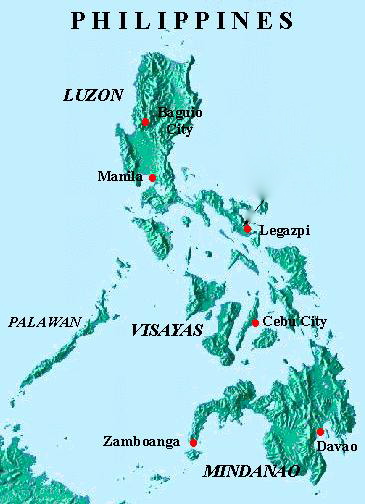 |
|
The Spanish-American War, 1898
On April 25, 1898 the United States declared war on
Spain following the sinking of the
Battleship Maine in Havana harbor on
February 15, 1898. Spain was by this time a decaying, weak empire, and
no match for a vigorous, muscular American military kept in shape by
killing American Indians. On May 1, 1898, U.S. ships sent from Hong Kong
to the Philippines, won the
Battle of Manila Bay. The war ended with the
signing of the Treaty of Paris on December 10, 1898. As a result Spain
lost it's control over the remains of it's overseas empire; Cuba, Puerto
Rico, Guam, and Spain agreed to sell the
Philippines to the United
States for the sum of $20 million. The Moros expected independence after
America defeated Spain in 1898. The fighting largely spared Mindanao and
surrounding southern islands, inhabited by Moros. Preoccupied American
forces left the Moros alone until matters were settled in the north.
Moro Rebellion
America’s first jungle war remains largely unknown,
except in the
Philippines where it began in 1900. Even those rare
Americans who have heard of the U.S. jungle war against the Moros often
connect it erroneously with the Philippine Insurrection. The Moro people
resisted U.S. invasion of the island of Mindanao, Philippines, with such
courage and bravery such as in the Battles of Bud Bagsak and Bud Dajo,
that the armed resistance to U.S. occupation was extended till 1913
(though the U.S. officially declared the "Philippine Insurrection"
terminated by 1902). The Moro resistance to both Spanish and U.S.
colonization is often downplayed by official historical accounts.
Until the spring of 1902, the Americans were not seriously involved
except by the sudden, frightening attacks of individual Amoks and
Juramentado. An amok was a Moro who, for a variety of personal reasons,
went berserk and tried to kill as many of the enemy as possible before
meeting his own, expected death. Juramentados were perhaps even
deadlier, since they were religiously motivated, swore a formal oath
before the proper Muslim authority to attack anybody considered to be a
foe of Islam, and always struck when and where least expected. Although
certain of their own extinction, those fanatics were secure in their
belief that they would be whisked to the Muslim paradise for their
valorous self-sacrifice. Both Amoks and Juramentados attacked with the
Malay
Kriss, a wavy-edged sword, in length halfway between a long dagger
and a saber and easily disguised under their clothes. In addition, they
were deadly with a blowgun and poison darts, and were quite good with
their muzzleloading rifles. |
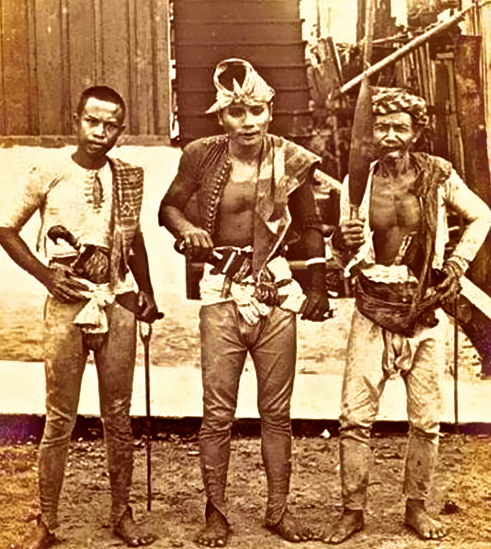
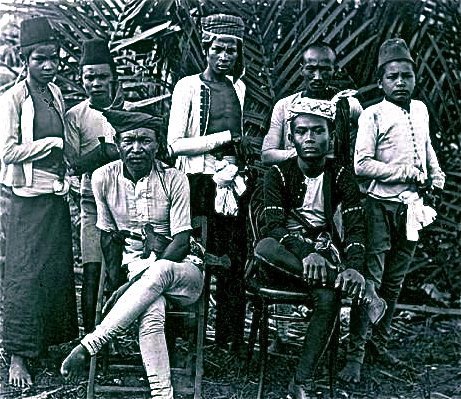 |
| Thus the Americans never knew when or where—from a jungle ambush, a
quiet street, in a marketplace—those zealots would strike. When they
did, however, such were their frenzied charges that they usually scored
devastatingly, since nearly all of them found at least one target on
their way to glorious death. A Juramentado at Zamboango, though hit in
seven different places by revolver shots, nevertheless reached an
American officer and sliced off one of his legs! Into this slowly
boiling pot, in the spring of 1902, the U.S. military command sent
40-year-old Captain John Pershing, a West Point veteran of Indian
fighting in the United States. He believed that the Moros were savages
who respected nothing but force. But the Mindanaos took to sniping and
cutting telegraph wires. In response Pershing attacked Bayan. Every Moro
settlement of any size was defended by a Cota, a fort made of bamboo and
mud 75 to 100 feet square, with walls 12 to 21 inches thick. Cotas were
usually surrounded by trenches 5 to 30 feet deep, in front of which the
Moros often planted loosely covered sharpened stakes to further inhibit
attackers. Cotas were also defended by Lantakas, small, artistically
made brass cannons. At Bayan, the Americans set the pattern for all
ensuing clashes with the Moros—a light artillery bombardment, which was
typically both deadly and decisive, followed by a charge through what
was left of the enemies’ defenses. The Sultan of Sulu warned,
“Americans,” he said, “were like a match box. If you strike one they all
go off!”
Pershing’s successor was
Maj. Gen. Leonard Wood.
General Wood thought
the Moros were an excessively brave but depraved race of pirates,
bandits and outlaws. They were “stupid fighters, utterly unable to stand
up in the open....Their strong point was attempted ambush…though brave,
they die foolishly....they should attack at night en masse where their
dexterity with swords and spears would count most.” The only way to
handle Moros was to be just and firm: “Every concession to them is a
mistake.” |
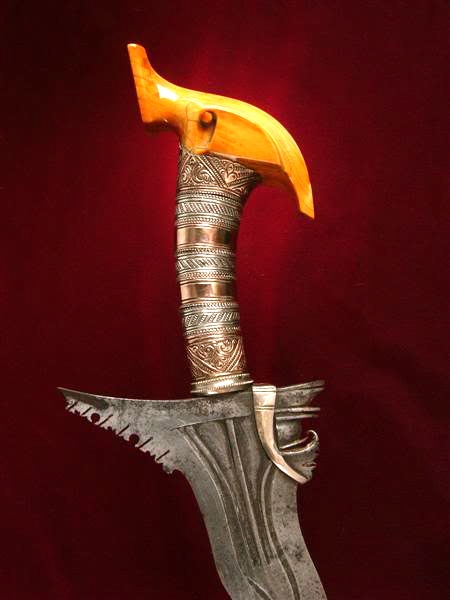 |
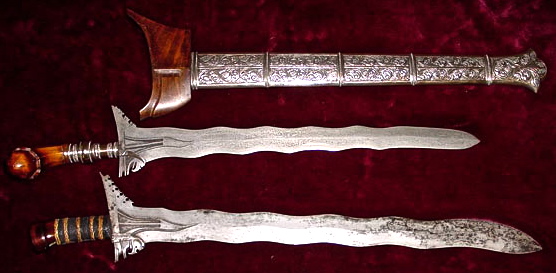 |
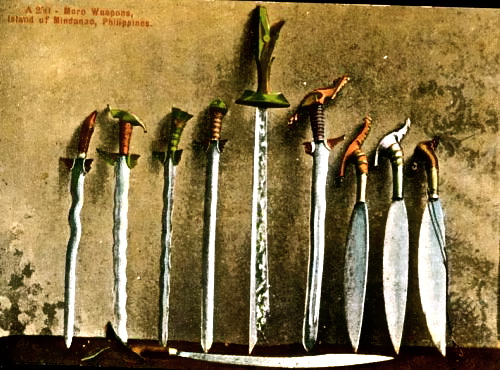 |
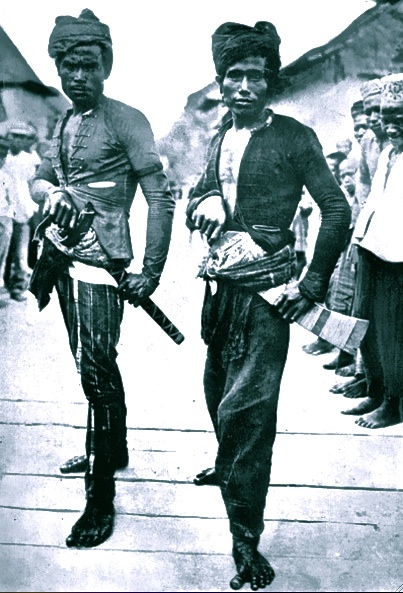 |
Americans won essentially all engagements in this
11-year campaign because the Moros were incompetent insurgents,
preferring to fight from behind massive earthwork forts rather than in
the jungle, which was perfect for guerrilla warfare. The Americans never
ceased to wonder why the Moros did not take to the dense jungle where,
with their Amoks and Juramentados, they could strike far more
effectively from ambush. For their part, the Moros could not understand
why the Americans did not destroy every Cota in the area.
The American position in the Philippines was not to destroy the Moros,
but intended instead to suppress piracy, eliminate the slave trade,
prevent intertribal war and bring the “natives” into the modern world.
But piracy, slavery and
fighting were as much a part of the Moro way of
life as was Islam. The Moros saw those well-meant but abrupt changes as
threatening to their religion and their social fabric.
One of the bloodiest battles of the whole Moro experience occurred
near Jolo City in March 1906, when the Moros there made a determined
stand in the crater of an extinct volcano,
Bud Dajo. In what came to be
known as the
“Battle of the Clouds” because it was fought largely at an
elevation of 2,000 feet, the Americans launched a heavy bombardment
followed by an assault over fallen trees and around huge boulders.
American casualties were 21 killed and 73 wounded, against the more than
600 Moros dead,
some of them women dressed as men.
Pershing left in 1903, but returned in 1909 as governor. He supported
reforms but chafed at the persistent disorder. His solution was to
disarm everyone. He proceeded with his usual efficiency and made great
use of the native constabulary. Much bloodshed followed, but he
ultimately succeeded.
June 1913, when the Moros challenged their enemies at
Bud Bagsak in what would be the
ultimate battle of the American
experience in Moro territory. Although the 6,000 to 10,000 Moros engaged
were the greatest concentration the Americans ever faced in the
Philippines, the Moros lost to superior weaponry, with at least 500
killed. |
| The Philippines did not gain independence until 1946, but already by the
1930s the Philippine army was battling Moro rebels, and it still is
today.
The Moros never accepted rule from Manila. They are better equipped to fight for a homeland of their own in
Mindanao and Sulu than ever before. Powerfully armed and trained by
wealthier Muslims, they clamorously demand self-rule. 300 years after
the Spanish assaults and 100 years after the American efforts, the Moros
are as resistant as ever. One can only marvel today at the staying power
of the Moros’ ferocious dedication. |
|
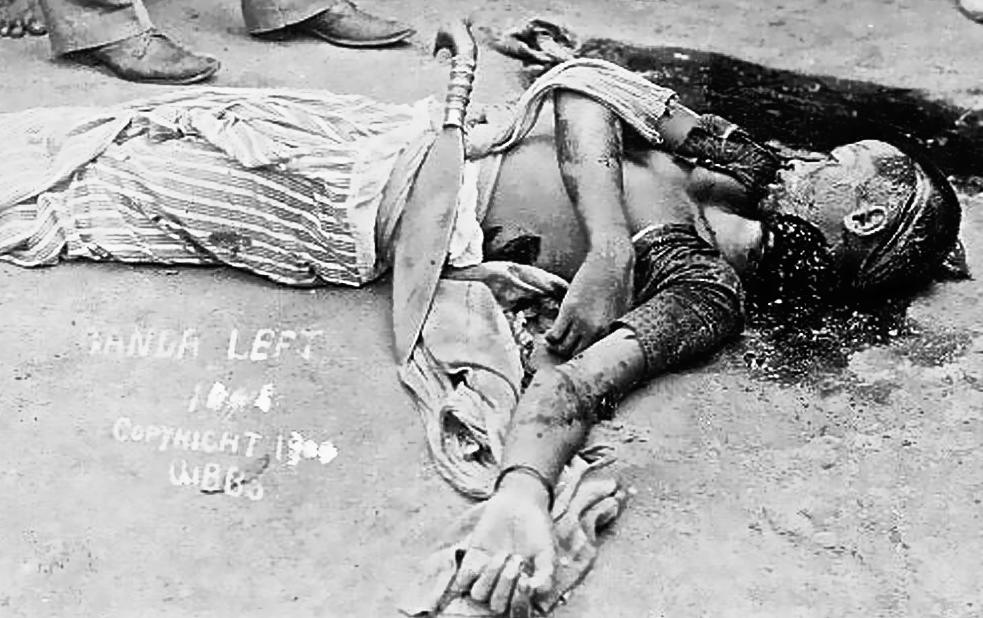 |
|
The Malay Moros
- Mindanao, Philippines . . circa 1900
The Moros, a Malay Muslim
warrior elite, in 1900 numbered 300,000 persons and controlled Mindanao,
the second largest of the Philippine Islands, together with a scattering
of smaller islands to the south and west of Mindanao known as the Sulu
Archipelago. Culturally, the Moros are Malays, mixed with the blood of
negro slaves, Filipino Tribal Hillmen, Chinese, and Dyak pirates and the
result is a unique and ferociously independent people. Polygamy and
slaveholding were significant parts of Moro culture in 1900. All a Moro
wanted was to be left alone to rob, plunder and fight. The Moro
philosophy, "That he should take who has the power, and he
should keep who can."
Those who denied him these
"rights" were his enemies, and the Moro knew how to deal with an enemy
in only one way. If the Americans wanted to abolish slavery let them
come and try. The Moros were prepared to fight these new invaders as
they had first fought the Spaniards nearly 400 years before. As General
Pershing wrote in 1913, while still a captain in the Philippines. . .
"The Moro is not at all over-awed or impressed by an overwhelming force.
If he takes a notion to fight, it is regardless of the number of men he
thinks are to be brought against him. You cannot bluff him!"
The Moro's only real allegiance, besides his religion, was to his "Datu"
or chieftain. These Datus ruled as feudal pirate princelings from
numerous fortified "Cottas" (villages) scattered throughout their island
domains. The Datus in turn recognized a general advisory authority in
the Sultan of Sulu. The cottas were heavily fortified, sometimes built
of stone, and bristling with old Spanish cannon and brass wall-guns
known as "Lantakas". From these strongholds a Datu would lead his
warriors forth in raids upon his neighbors (who were in turn raiding
him), or on any unwary travelers or foolish foreign interlopers. Warfare
was a fact of everyday life for the Moro. He was proud, vain, and
fearless. And war was more than just a mere pastime. It often had
religious overtones.
The Moros as Muslims
believed that one who takes the life of an infidel increases his own
rewards in paradise. From time to time a Moro desiring a short road to
glory would bathe in a sacred stream or spring, shave off his eyebrows,
and after dressing all in white would take a holy oath before the
village priest to die killing infidels. Such a "Juramentado" (From the
Spanish for one who has taken an oath) then hid a Kriss or Barong under
his clothes and sought the nearest infidel.
The weapons and physique of
the Moros were particularly suited to the slash and hack school of
combat. Moro men were of medium height, and their physical development
was often superb. They dressed in tight pants or pantaloons, vest,
jacket, sash and small tight turban. Chain Mail and plumed helmets were
also worn widely, especially by Datus. It was common practice for
warriors to don black trousers for fighting. All males age 16 or older
went about armed constantly. The Moros made their own steel weapons,
which were often beautifully finished, and always admirably adapted to
the purpose for which they were intended. For deadly serious fighting
the Moro could carry a large, painted circular shield of lightwood or a
lance. Tactics were simple; ambush and rush. Once close enough to use
his weapons a Moro was nearly unstoppable.
In close combat they usually trusted to a "Barong", a weapon somewhat
like a butcher's meat cleaver with a thick back and a razor thin cutting
edge. Normally only about 16-18" long, it was capable of inflicting
fearful injuries. To lop off a head, arm, or leg with a barong was
merely child's play. The strong and skillful warrior prided himself on
being able to halve an opponent with a single blow.
The straight "Kriss" was a
narrow bladed, 2-edge sword used for cutting and thrusting. The "Serpent
Kriss" with its wavy double-edged blade was used for thrusting and
inflicting a horrible wound. The Serpent Kriss was the classic Malay
weapon.
Finally, Moros not infrequently used a straight edged, two-handed sword
known as a "Campilan." The blade was wide at the tip and narrowed
steadily towards the hilt. It was used with great effect for cutting and
hacking.
The Moro seldom succeeded
to obtain firearms. Guns ranged from antique matchlocks and trade
muskets to captured Remingtons, Mausers, Springfields and Krags.
Ammunition was scarce. Colonial authorities severely restricted the
supply and ownership of firearms by any Filipino. Gunrunning was a very
serious offense.
|
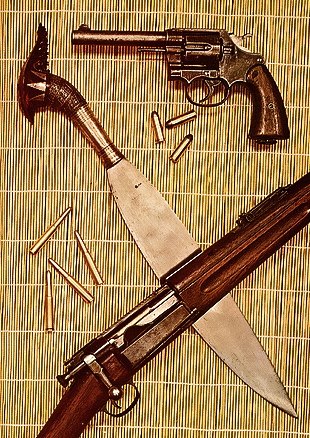 |
 |
|
 |
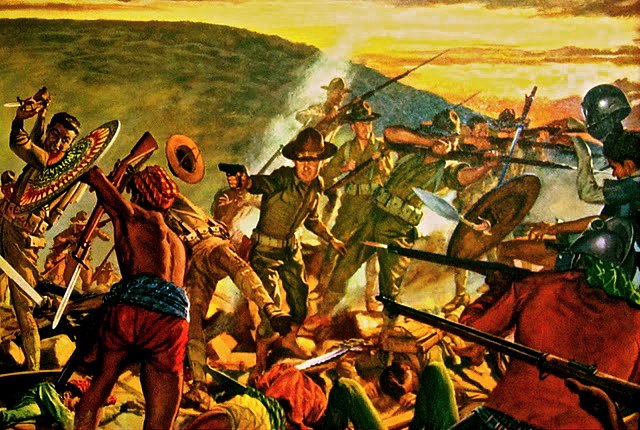 |
When President Theodore Roosevelt
declared the Philippines War officially over on July 4, 1902, the
proclamation's second preamble contained a caveat. The war was done, it
stated, "except in the country inhabited by the Moro tribes."
During its campaign against the Moros, the U.S. Army adopted the Colt
.45 Model 1911 semiautomatic pistol after American soldiers found that
the .38 caliber Long Colt and Smith and Wesson revolvers they
had previously used were
unable to stop the fierce Moro
Warriors of the
Southern Philippines. Eyewitness accounts describe Moros continuing to
kill American soldiers with their Barongs and Kriss after receiving
multiple rounds from the .38 pistols and .30 caliber rifles.
Realizing the Moro was tougher than any opponent previously encountered,
the Army requested guns with more “knocking power” to physically shock
and immobilize their opponents. |
|
The 1911 .45 Auto Pistol was
designed by
John M. Browning
In response to problems encountered by American units fighting Moro
tribesman during the Philippine-American War, the then-standard Colt
M1892 revolver, was found to be unsuitable for the rigors of jungle
warfare, particularly in terms of stopping power, as the Moros had very
high battle morale and frequently used drugs to inhibit the sensation of
pain. To prepare for battle, the Moro fighter would bind their limbs
with leather, take narcotics, and use religious ritual to gain an
altered state of consciousness, which turned them into almost
unstoppable fighters. The Colt pistol round the U.S. soldiers used
simply would not stop the Moro fanatic. The Krag rifles the U.S.
soldiers carried were barely more effective.
The new weapon design process to replace the .38 started in 1906. On
March 29th, 1911, the Browning designed, Colt produced, 45 Automatic
Pistol, was selected as the official sidearm of the Armed Forces of the
U.S.A., named Model 1911. Browning's pistols passed a test series, and
it was the first firearm to undergo such a test, firing continuously
6000 cartridges. The Browning design for the US Military pistol trials
was a magazine fed, gas operated, semi-automatic pistol. Browning earned
the lasting reputation as “The Father of Automatic Fire.” Browning’s
design genius was not limited to pistols. Among his other military
inventions were the Browning Automatic Rifle (BAR), numerous .30 caliber
and .50 caliber machine guns, etc..
It has been to war for over 100 years |
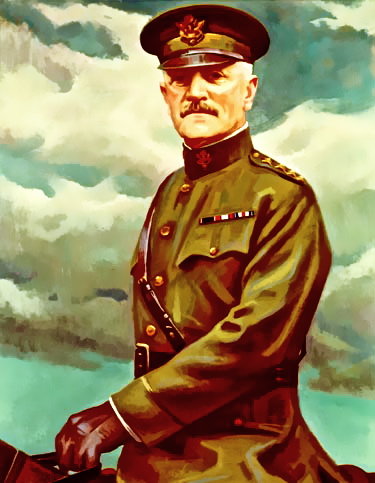
John Pershing wrote of the Moros:
"The only principle for which they fought was the right to pillage and
murder without molestation from the government." |
|
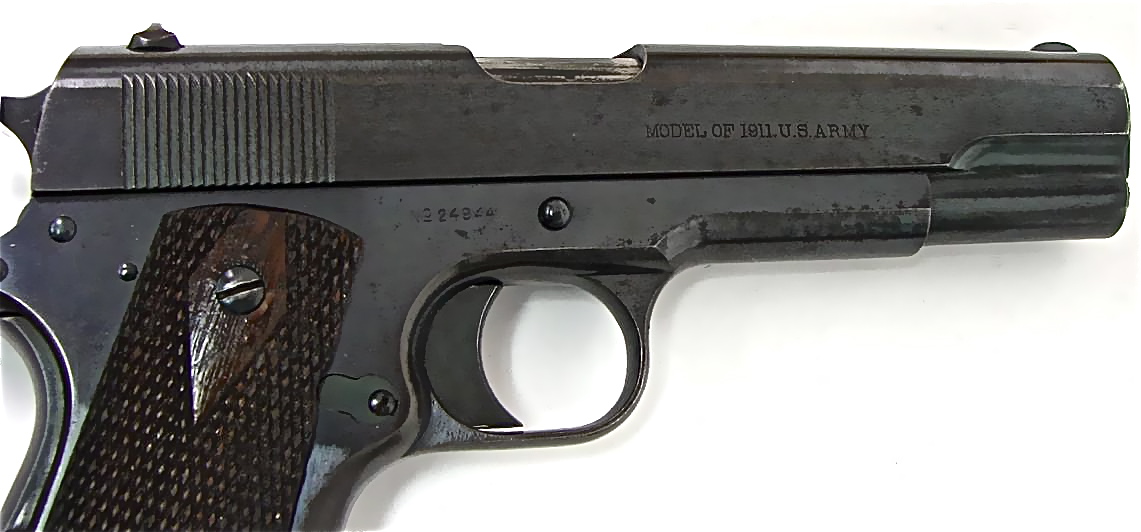 |
|
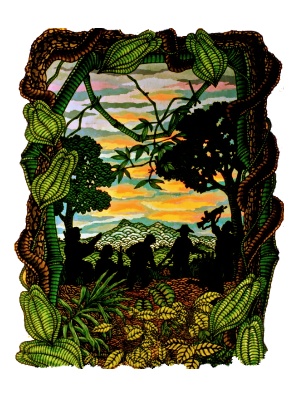 |
 |
|
Philippines Launches Air Attack on
Moro Rebels
October 24th, 2011
MANILA: The Philippines launched its first air strikes in three years against Muslim separatist
rebels in the restless south, after a series of attacks that left 35
people dead, the military said. Two OV-10 attack planes bombed a remote
village on the edge of Payao town on Mindanao island, where Moro
Islamic Liberation Front (MILF) rebels have been entrenched since
last week, army spokesman Major Harold Cabunoc said. The 12,000-strong
MILF has waged a rebellion since the 1970s in Mindanao, the country's
southern third, which the minority Muslims consider their ancestral
homeland.
And while the government has been involved in peace talks with the rebel
leadership since 2003 and the two sides are currently observing a
ceasefire, the group targeted in the bombing was a breakaway faction.
"The bombing attacks began at 11.30 am," Cabunoc said. "About 100
heavily armed bandits are holed up in their bunkers and running
trenches." There were no immediate reports of casualties, but the
military said about 3,000 civilians had already fled the area last week.
He said a combined contingent of 200 police and military commandos on
the ground were also involved in the operation. Regional military
spokesman Lieutenant Colonel Randolph Cabangbang said the gunmen
targeted by the air strikes were rogue MILF rebels who were involved in
kidnapping and other criminal activities. The same group of rebels was
blamed for ambushes that killed four soldiers and four policemen.
Those attacks came just two days after 19
special forces were gunned down by MILF fighters after they strayed into
rebel territory on Basilan island, also in Mindanao. Five rubber
plantation workers and three soldiers meanwhile were killed in separate
attacks, while 200 rebels also occupied two elementary schools in remote
farming villages, stealing cattle and harassing residents.
In the wake of the attacks, President Benigno Aquino has come under
increasing pressure from restive military officers and critics to
suspend its ceasefire. British ambassador Stephen Lillie called on the
Moro Islamic Liberation Front
to order its commanders to silence their guns. "I
am seriously concerned by the reports of ambushes by members in
different parts of Mindanao over the past week," Lillie said in a
statement. "The current spate of ambushes must stop," he added. But he
warned that meeting violence with violence could "likely lead to a
downward spiral of killing, with untold misery and suffering for
innocent civilians".
More than 30 years of fighting have claimed about 150,000 lives and
stunted efforts to develop the mineral-rich southern region. A ceasefire
signed in 2003 paved the way for peace talks between the
Moro Islamic Liberation Front and
the government, but the truce is often marred by violence and the talks
are currently at an impasse. |
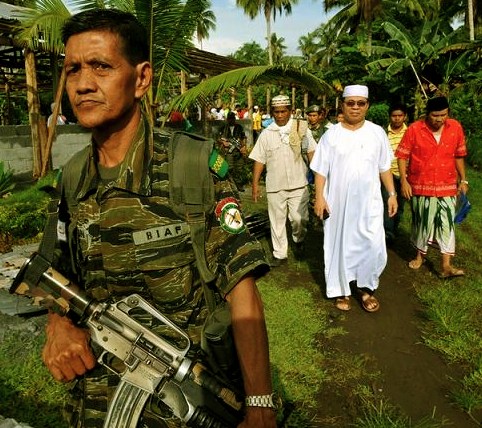
Murad Ibrahim, Chairmen of the
Southern Philippine Moro Islamic Liberation Front
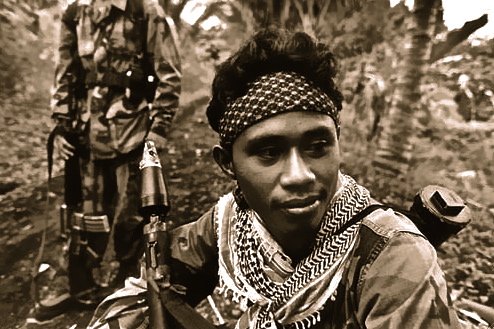 |
|
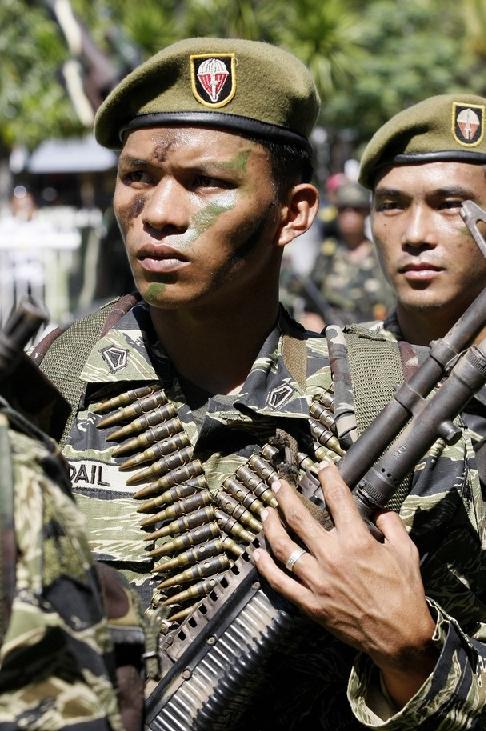
Phillippine Army - Mindanao |
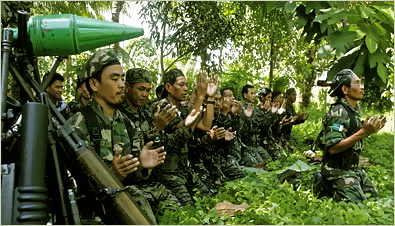
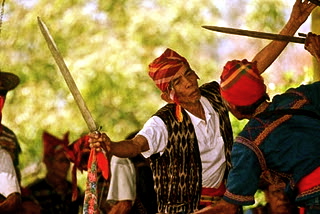
B'laan Tribesmen Perform Traditional Moro Victory
Dance |
"It pains me to know that we are fighting against our own people,"
said Moro National Liberation Front leader Habib Mudjahab Hashim. "What
has happened is painful and sad and I am wondering what motivated the
two to fight each other."
MNLF guerrillas and Abu Sayyaf fighters have been battling one another
on the island of Jolo, with up to 26 deaths reported.
Hashim added that those involved in the clashes were legitimate MNLF
members and former forces of the group that "have allied with the ASG." |
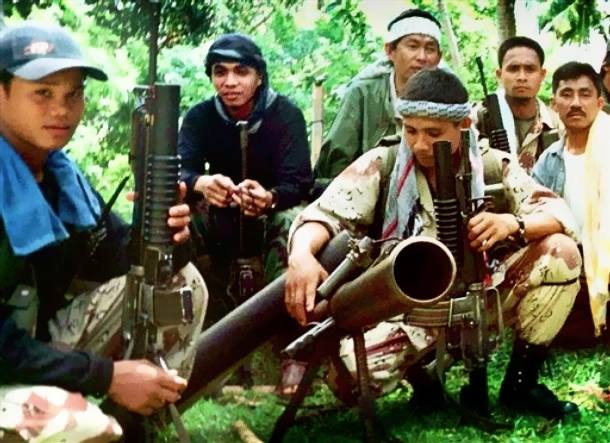
Moro Abu Sayyaf |
Seeking to contain the violence, the Armed Forces of the Philippines
stated that the MNLF simultaneously attacked two ASG camps in Patikul,
Sulu.
AFP spokesman Col. Arnulfo Marcelo Burgos said the 2nd Marine Brigade
has been deployed in the vicinity to help the Philippine National Police
prevent a spillover of the MNLF-ASG armed clashes, adding that
government forces weren't involved in the violence.
Burgos said that four MNLF fatalities were beheaded by ASG members.
Second Marine Brigade commander Col. Orlando de Leon said the gun
battles had caused at least 22 fatalities.
"Unverified reports indicated that both sides suffered casualties. On
the side of the MNLF, reports that reached us show that eight died on
their side. On the Abu Sayyaf, more or less 14 died on their side," de
Leon said. |
Pacification efforts may prove difficult however, as a senior MNLF
field commander stated that former MNLF commander Ustadz Habier Malik is
already fed up with the "un-Islamic acts of the ASG" in the province and
that the ASG "bandits" should be "eliminated in the soonest possible
time" to ease the situation in Sulu.
Filipino presidential spokesman Edwin Lacierda noted that the MNLF-ASG
clash "is occurring in a specific isolated area."
Lacierda stated that while the government still has no details on why
the MNLF and ASG militants were fighting, the government's highest
concern was civilians caught in the crossfire.
"So right now, they are being evacuated and Social Welfare Secretary
Dinky Soliman is in fact in Mindanao right now and we have identified
evacuation centers already," he said. "... The civilians that have been
removed in those areas are now in evacuation centers."
Lacierda said the government isn't concerned that the MNLF, which forged
a peace agreement with the government in the mid-1990s, would again
engage in conflict with other armed groups in Mindanao following the
clash, noting that a number of amnestied former MNLF guerrillas have
been given government employment. |
|
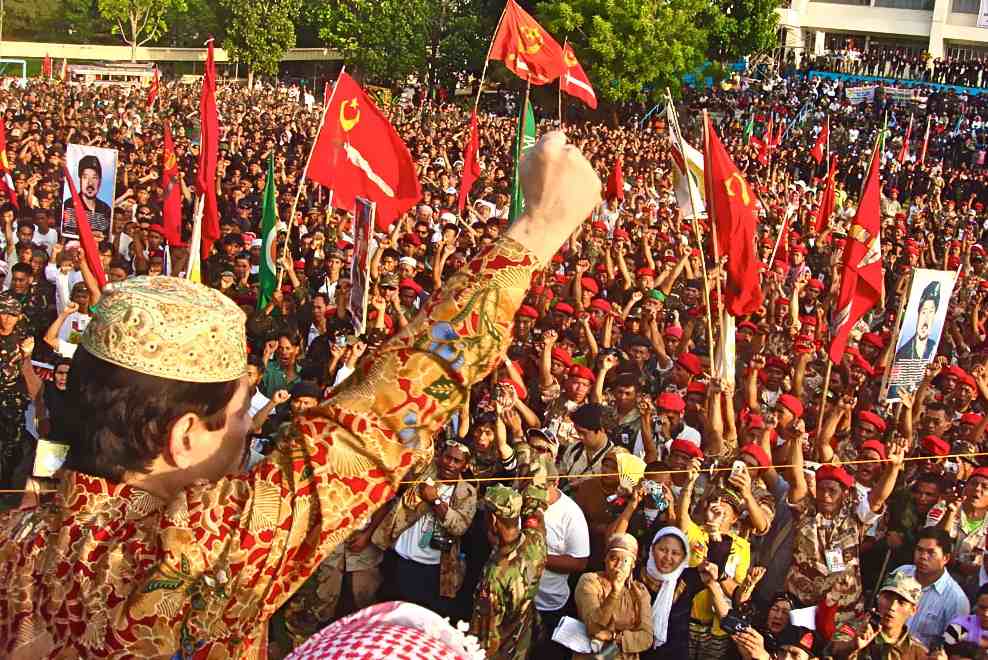 |
|
"Moro National Liberation Front"
Rally |
|
The Philippines' largest Muslim
rebel group has condemned extremist jihadists in Iraq and Syria, and
vowed to stop the spread of their "virus" into the Southeast Asian
nation. |
After decades of armed rebellion that claimed tens of thousands of
lives, the Moro Islamic Liberation Front (MILF) signed a peace agreement
in March 2014, that commits it and the national government to share
power in the area.
The MILF portrayed its moderate leadership as vital to stopping the
savage ideology of Islamic State (IS) infecting the southern Muslim
regions of the mainly Catholic Philippines.
"The MILF condemns barbarism and savagery whether done by other groups
including the ISIS or even by its (MILF's) own members," the MILF said
in an editorial posted on its www.luwaran.com website this week.
"Frankly, it is the power, moderating line, and influence of the MILF
that hinders the birth of a truly strong radical group." |
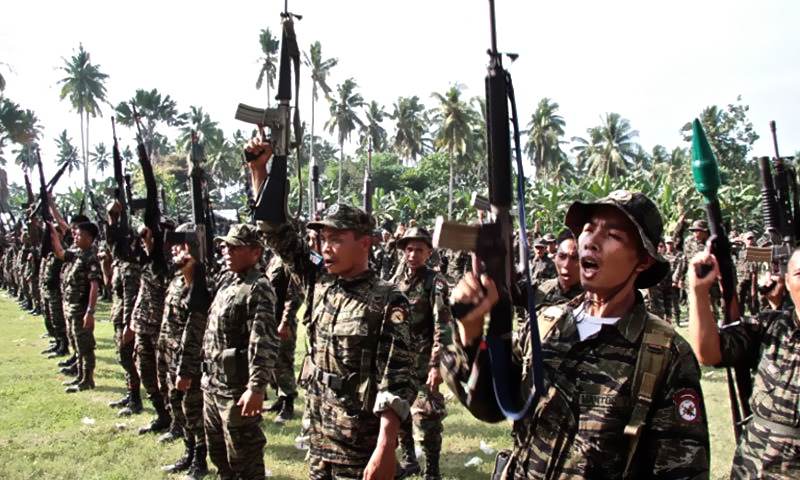 |
The MILF also said a planned Muslim autonomous region that is the
centrepiece of the peace deal would be a bulwark against the ideology of
the Islamic State, which is also known as ISIS.
The MILF urged President Benigno Aquino to approve a draft bill to
create the autonomous region, which was submitted to him last week by a
joint committee of rebel and government negotiators.
The peace agreement had called for Aquino to submit the bill to Congress
earlier this year, so the autonomous region would be in place by the
time he leaves office in mid-2016.
But he rejected an earlier draft and had the joint committee prepare a
revised version.
"It is this... fear (of) not being able to realize it (passage of the
Muslim autonomous law) for whatever reason that the ISIS' virus is much
to be feared," the MILF warned.
Two other Filipino Muslim armed groups, the Abu Sayyaf and the
Bangsamoro Islamic Freedom Fighters (BIFF), have recently vowed
allegiance to the IS in video clips uploaded on the Internet.
Some politicians have expressed concern both groups may be sending
recruits abroad to fight alongside the IS, though the Philippine
military said there was no evidence of this.
The Abu Sayyaf is a loosely organized Al-Qaeda-linked group of several
hundred militants blamed for the Philippines' deadliest terrorists
attacks.
The BIFF, which has about 200 fighters, split from the MILF after
rejecting peace talks and has vowed to continue pursuing an independent
Islamic state.
"For us, the threat is not in the two groups' joining the ISIS. Their
numbers are too tiny to be felt and make a difference," the MILF said.
"The threat really comes from the extremism espoused by the ISIS. Ideas
are contagious and infectious." |
|